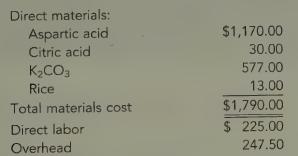Nutratask, Inc., is a pharmaceutical manufacturer of amino-acid-chelated minerals and vitamin supplements. The company was founded in
Question:
Nutratask, Inc., is a pharmaceutical manufacturer of amino-acid-chelated minerals and vitamin supplements. The company was founded in 1974 and is capable of performing all manufacturing functions, including packaging and laboratory functions. Currently, the company markets its products in the United States, Canada, Australia, Japan, and Belgium.
Mineral chelation enhances the mineral’s availability to the body, making the mineral a more effective supplement. Most of the chelates supplied by Nutratask are in powder form, but the company has the capability to make tablets or capsules.
The production of all chelates follows a similar pattern. Upon receiving an order, the company’s chemist prepares a load sheet (a bill of materials that specifies the product, the theoretical yield, and the quantities of materials that should be used). Once the load sheet is received by production, the materials are requisitioned and-sent to the blending room. The chemicals and minerals are added in the order specified and blended together for two to eight hours, depending on the product. After blending, the mix is put on long trays and sent to the drying room, where it is allowed to dry until the moisture content is 7 to 9 percent. Drying time for most products is from one to three days.
After the product is dry, several small samples are taken and sent to a laboratory to be checked for bacterial level and to determine whether the product meets customer specifications. If the product is not fit for human consumption or if it fails to meet customer specifications, additional materials are added under the direction of the chemist to bring the product up to standard. Once the product passes inspection, it is ground into a powder of different meshes (particle sizes) according to customer specifications. The powder is then placed in heavy cardboard drums and shipped to the customer (or, if requested, put in tablet or capsule form and then shipped).
Since each order is customized to meet the special needs of its customers, Nutratask uses a job-order costing system. Recently, Nutratask received a request for a 300-kilogram order of potassium aspartate. The customer offered to pay $8.80/kg. Upon receiving the request and the customer’s specifications, Lanny Smith, the marketing manager, requested a load sheet from the company’s chemist. The load sheet prepared showed the following material requirements:
Overhead is applied using a companywide rate based on direct labor dollars. The rate for the current period is 110 percent of direct labor dollars.
Whenever a customer requests a bid, Nutratask usually estimates the manufacturing costs of the job and then adds a markup of 30 percent. This markup varies depending on the competition and general economic conditions. Currently, the industry is thriving, and Nutratask is operating at capacity.
Required:
1. Prepare a job-order cost sheet for the proposed job. What is the expected per-unit cost? Should Nutratask accept the price offered by the prospective customer? Why or why not?
2. Suppose Nutratask and the prospective customer agree on a price of cost plus 30 percent. What is the gross profit that Nutratask expects to earn on the job?
3. Suppose that the actual costs of producing 300 kg of potassium aspartate were as follows:
What is the actual per-unit cost? The bid price is based on expected costs. How much did Nutratask gain (or lose) because of the actual costs differing from the expected costs? Suggest some possible reasons why the actual costs differed from the projected costs.
4. Assume that the customer had agreed to pay actual manufacturing costs plus 30 percent.
Suppose the actual costs are as described in Requirement 3 with one addition:
an underapplied overhead variance is allocated to Cost of Goods Sold and spread across all jobs sold in proportion to their total cost (unadjusted cost of goods sold).
Assume that the underapplied overhead cost added to the job in question is $30.
Upon seeing the addition of the underapplied overhead in the itemized bill, the customer calls and complains about having to pay for Nutratask’s inefficient use of overhead costs. If you were assigned to deal with this customer, what kind of response would you prepare? How would you explain and justify the addition of the underapplied overhead cost to the customer’s bill?LO1
Step by Step Answer:

Introduction To Cost Accounting
ISBN: 9780538749633
1st International Edition
Authors: Don R. Hansen, Maryanne Mowen, Liming Guan, Mowen/Hansen





